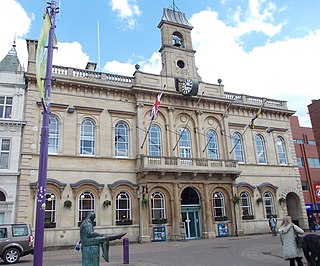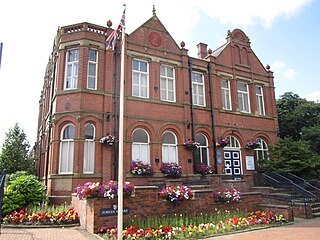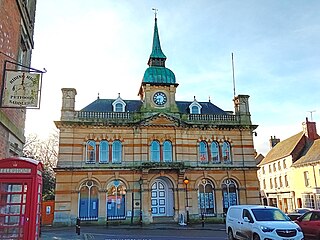Related Research Articles

Whitefield is a town in the Metropolitan Borough of Bury, Greater Manchester, England. It lies on undulating ground above the Irwell Valley, along the south bank of the River Irwell, 3 miles (4.8 km) southeast of Bury, and 5 miles (8.0 km) northwest of Manchester. Prestwich and the M60 motorway lie just to the south.

Prestwich is a town in the Metropolitan Borough of Bury, Greater Manchester, England, 3 miles (4.8 km) north of Manchester, 3 miles (5 km) north of Salford and 5 miles (8.0 km) south of Bury.

Radcliffe is a market town in the Metropolitan Borough of Bury, Greater Manchester, England. It lies in the Irwell Valley 7 miles (11 km) northwest of Manchester and 3 miles (5 km) southwest of Bury and is contiguous with Whitefield to the south. The disused Manchester Bolton & Bury Canal bisects the town.

Pendlebury is a town in the City of Salford, Greater Manchester, England. The population at the 2011 Census was 13,069. It lies 4 miles (6 km) north-west of Manchester, 3 miles (5 km) north-west of Salford and 6 miles (10 km) south-east of Bolton.

The Loughborough Town Hall is a building fronting onto the Market Place in Loughborough, Leicestershire, England. Built as a corn exchange and ballroom in 1855, it later became a municipal building and subsequently a theatre. It is a Grade II listed building. The building is still used for full council meetings of Charnwood Borough Council.

Runcorn Town Hall is in Heath Road, Runcorn, Cheshire, England. It is recorded in the National Heritage List for England as a designated Grade II listed building. It was originally built as Halton Grange, a mansion for Thomas Johnson, a local industrialist. After passing through the ownership of two other industrialists, it was purchased in the 1930s by Runcorn Urban District Council and converted into their offices. Since 1974, it has been the meeting place for Halton Borough Council.

Reading Town Hall is the town hall of Reading, Berkshire, England. The town hall was built in several phases between 1786 and 1897, although the principal facade was designed by Alfred Waterhouse in 1875. Situated close to the site of Reading Abbey, it is adjoined to the north by the Hospitium of St John and to the south by St Laurence's Church.

The Old Town Hall was a former municipal facility at the corner of King Street and Rodney Street in Wigan, England. The building, which was demolished in September 2013, had been designated a Grade II listed building in 1990.

Acton Town Hall is a municipal building in High Street, Acton, London, England. It is a Grade II listed building.

Stratford Town Hall is a municipal building in Stratford, London. It is a Grade II listed building.

Denton Town Hall is a municipal building in the Market Street, Denton, Greater Manchester, England. The town hall is the meeting place of Denton Town Council and is also used as a public library.

Towcester Town Hall is a municipal building in Watling Street, Towcester, Northamptonshire, England. The town hall, which is the meeting place of Towcester Town Council, is a grade II listed building.

Folkestone Town Hall, also known as The Guildhall, is a municipal building in Guildhall Street, Folkestone, Kent, England. The town hall serves as the headquarters of Folkestone Town Council, and also houses the Folkstone Museum. It is a Grade II listed building.

Godalming Borough Hall is a municipal building in Bridge Street in Godalming, a town in Surrey, England. The building was the meeting place of Godalming Town Council.

Cheetham Town Hall is a former municipal building in Cheetham Hill Road, Cheetham, Manchester, England. The structure, which now operates as a restaurant, is a Grade II listed building.

Ashton-in-Makerfield Town Hall, formerly Ashton-in-Makerfield Urban District Council Offices, was a municipal building in Bryn Street, Ashton-in-Makerfield, a town in Greater Manchester, England. The building, which served as the offices and meeting place of Ashton-in-Makerfield Urban District Council, was demolished in 2017.

Mossley Hall, formerly known as Mossley Town Hall, is a former municipal building in Stamford Road, Mossley, a town in Greater Manchester in England. The building, which served as the offices and meeting place of Mossley Borough Council, is a grade II listed building.

Tottington Hall, also known as Tottington Town Hall, is a municipal building in Market Street, Tottington, a town in Greater Manchester in England. The building, which served as the offices and meeting place of Tottington Urban District Council and now operates as a public library, is a grade II listed building.

Whitefield Town Hall was a municipal building off Pinfold Lane, Whitefield, a town in Greater Manchester in England. The building, which served as the offices and meeting place of Whitefield Urban District Council, was demolished in 2021.
Frome Town Hall is a municipal building in Christchurch Street West in Frome, a town in Somerset, in England. It currently accommodates the offices and meeting place of Frome Town Council.
References
- 1 2 Historic England. "Manor Park Rest Home (1067228)". National Heritage List for England . Retrieved 6 March 2024.
- ↑ "Central Station (now GMEX), Windmill Street, Manchester". Manchester Architects 1800–1940. Retrieved 8 March 2024.
- ↑ "Ordnance Survey Map". 1850. Retrieved 8 March 2024.
- 1 2 3 "Bent Hill". Prestwich. Retrieved 6 March 2024.
- ↑ "St Paul's Church, Kersal Moor: Churchyard Trail" (PDF). The Victorian Society. p. 7. Retrieved 6 March 2024.
- ↑ Hindle, Paul; Wilkinson, Harry (2020). Prestwich and Whitefield Through Time. Amberley Publishing. ISBN 978-1445699479.
- ↑ "Prestwich Housing Scheme, Bent Hill Estate, Prestwich". Manchester Architects 1800–1940. Retrieved 8 March 2024.
- ↑ "HMS Utmost (N19)". U Boat.net. Retrieved 6 March 2024.
- ↑ "Prestwich Borough Roll Of Honour WW2". Imperial War Museum. Retrieved 6 March 2024.
- ↑ "No. 46179". The London Gazette . 11 January 1974. p. 483.
- ↑ Local Government Act 1972. 1972 c.70. The Stationery Office Ltd. 1997. ISBN 0-10-547072-4.
- 1 2 "Bid to save old town hall". Lancashire Telegraph. 19 June 2001. Retrieved 6 March 2024.